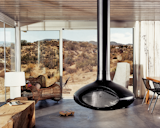5 Hot Tips to Remember When Planning Your Desert Prefab
The allure of prefab is based on three main components: it's efficient, economical, and ecologically-minded. The homes can be erected in record time with minimal intrusion on the landscape. Additionally, the components are generally light and precise, allowing for a foundation that's flexible to the rocky soils of the region. Fabricated with long-lasting materials and finishes that ensure longevity and low maintenance, prefab homes provide a comfortable living space even under severe weather conditions.
While exploring these prefabs that are perfect for the desert—thanks to thoughtful planning and a smart layout—read on to learn five best-practice measures to consider when designing your desert oasis.
The biggest challenges imposed by the climate are water scarcity, extreme temperature swings, and a rocky geology.
1. To begin, proper site placement should be a top priority.
The goal is to place your home where it can receive maximum solar radiation during the winter season and minimum radiation during the summer season. Communal rooms should be located on the outer faces to act as a thermal barrier to keep the bedrooms cool. Longer walls should face north and south, so that the building receives minimum solar exposure.
2. Design your home so that most windows face north or south.
Because they're harder to shade, east- and west-facing windows contribute much more to overheating than north- or south-facing windows—so east- and west-facing windows should be minimized. Windows can be recessed into thick walls, protected by deep eaves or canopies, and every effort should be made to shade all windows.
3. The thickness of wall plays an important role in moderating the thermal comfort within your home.
Thicker outer walls are preferred, as it behaves as an insulating barrier. On the floors, dense materials with thermal mass like tile, concrete, or masonry have the ability to absorb, then slowly release heat during the cooler hours.
4. The finish you choose for the exterior plays an important role as well.
Choosing light colors or reflective surfaces limits heat absorption and helps keep the interior of your home cool.
5. The dynamic temperature swings that are common in desert climates offers an opportunity to design indoor/outdoor covered spaces that are usable for much of the year.
A layout surrounding a courtyard provides cross ventilation and natural cooling. Incorporating water features go a long way in assisting with evaporation and cooling. Additionally, planting large shady trees—that are native to the region—near exterior walls provides a shaded, cooling canopy.
This Texas modular, dubbed the Marfa Weehouse, provides sweeping views from its sheltered deck. Conceptualized as the first in a three dwelling compounds, this home shelters a bedroom, bathroom, and a utility shed. Although only 400 square feet, the expansive steel pergola doubles the visual volume of this wee home.
More Dwell Prefab Articles
Published
Last Updated
Stay up to Date on the Latest in Prefab Homes
From cozy cottages to large family houses, see how prefab continues to redefine the future of construction, building, and design.









